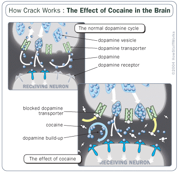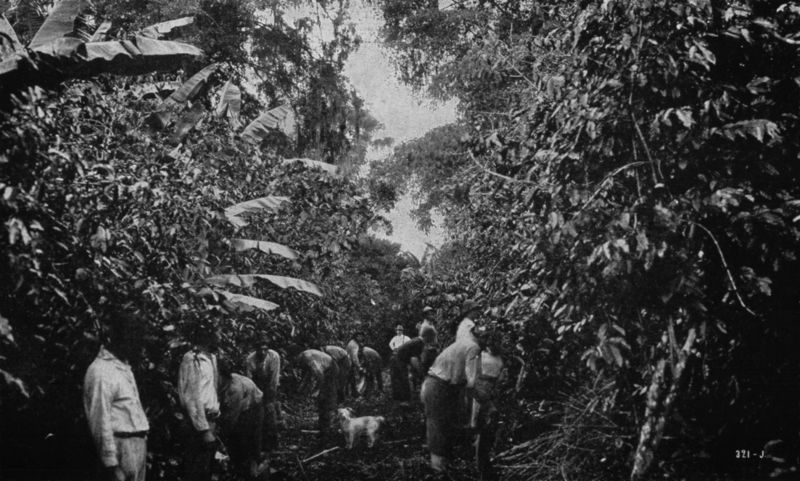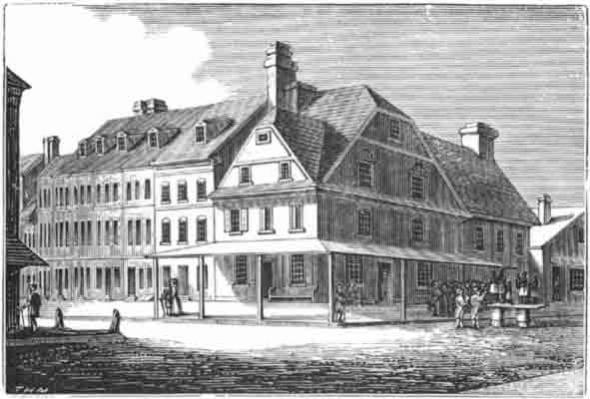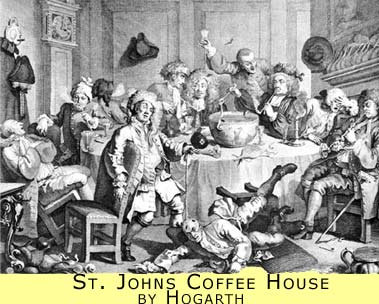May 8th, 2008 · Comments Off on Crack Epidemic ·
Introduction, Chemistry, How It Works, Physiological Effects, Health Risk, Crack Epidemic, Crack on Black Crime, Crack Killed the 80s and 90s, History, Crack in America
Crack cocaine use has created an epidemic in many urban and inpoverished inner cities. Crack has historically been associated with an “increase in homicide, family disruption, and a breakdown in response capacity of the law enforcement system”. (Wachtler, 1990) Furthermore the effects of use have been to be fatal. Crack can and has been responsible for complications during pregnancy and delivery (Chasnoff, Landress, & Barrett, 1990), as well there is the association of crack use with inceased vulnerability to sexually transmitted diseases such a syphillis, and HIV/AIDS, especially amongst black women. The danger of drug use, and especially for those addicted to crack, is the users binge consumption in which all other neccesities of life are trumped by the need to get high. “ Personal safety, hygeiene, nutrition, and family or occupational responsibilty are frequently ignored”. (Fullilove et al.)
Categories: Cocaine
Tags: William Scott —
May 8th, 2008 · Comments Off on Health Risk ·
Introduction, Chemistry, How It Works, Physiological Effects, Health Risk, Crack Epidemic, Crack on Black Crime, Crack Killed the 80s and 90s, cheap cialis online History, Crack in America, viagra canada References
While Crack creates a europhoric experience it leaves many potentially dangerous side effects in the body. Crack users have extremely high risk of heart attacks, respitory problems, stroke, and detrimental mental disorders.
As crack fulfills its purpose and moves through the blood stream the user initially feels the effect of the high and is energized, senses are hightened, and they are more aware of feeling sight and sound. The user’s blood pressure begins to rise and the heart rate increases. The user becomes restless and worrisome and anxious leading to dangerous paranoia.
Alongside the effects of the brain experienced through Crack use, HIV/ Aids and other STDs’ have been extremely prevalent amongst Crack users. The emergence of the “crack house” — “ a small apartment adapted for crack use. The kitchen is used for cooking crack, at least one bedroom is used for sex, and the living space is used for selling and smoking.”(Incardi, Ph.D, 1995) Around the sametime as the crack epidimic from 1986 to 1987, syphilis increased by 25%.(Shultz et.al., 1990) Acummulatin gevidence link these STD’s increases to the crack epidemic, in that rates were significantly higher among those that used crcak compare to those that did not. (Fullilove et al., 1990)
Categories: Cocaine
Tags: William Scott —
Introduction, Chemistry, How It Works, Physiological Effects, Health Risk, Crack Epidemic, Crack on Black Crime, Crack Killed the 80s and 90s, History, Crack in America, References
My name is Cocaine – call me Coke for short /I entered this assignment help uk country without a passport.
Ever since then I’ve made lots of scum rich./Some have been murdered and found in a ditch.
/I’m more valued than diamonds, more treasured than gold. /Use me just once and you too will be sold./I’ll make a schoolboy forget his books./I’ll make a beauty queen forget her looks./I’ll take renowned speaker and make a bore./I’ll take a mother and make her a whore./I’ll make a schoolteacher forget how to teach. /I’ll make a preacher not want to preach. I’ll take all your rent money and you’ll get evicted. /I’ll murder your babies or they’ll be born addicted./I’ll make you rob and steal and kill./When you’re under my power you have no will./Remember my friend my name is ” Big C “./If you try me just one time you may never be free. /I’ve destroyed actors, politicians and many a hero. /I’ve decreased bank accounts from millions to zero./I make shooting and stabbing a common affair. /Once I take charge you won’t have a prayer./Now that you know me what will you do ?/You’ll have to decide, It’s all up to you./The day you agree to sit in my saddle./The decision is one that no one can straddle./Listen to me, and please listen well./When you ride with cocaine you are headed for hell !!!
As evident in the “ My name is Cocaine” poem created by Larry Jackson, Crack cocaine has many effects on the brain chemistry of the addict or abuser. When consuming Crack cocaine works in a part of the brain called the ventral tegmental area (VTA) and a large amount of dopamine is released, Dopamine functions as a neurotransmitter, and activates the five dopamine receptors, and their variants. Dopamine increases the heart rate and blood pressure.




After a high of about Fifteen minutes the dopamine levels in the brain are lowered and the user is consumed by a feeling of depression, which inlist its addictive characteristics because the user is left looking for another high. As a result of the time it takes for Dopamine to replenish itself each successive hit or use of crack has a recessive high, making the satisfying search for the original high a cyclical never ending process. The short term effects of Crack use are typically
Categories: Cocaine
Tags: William Scott —
Introduction | History | How It Works
Uses | Typhoid Fever | Side Effects
Synthetic Production | U.S. and the West
References
- Abbot, Evelyn (1891). Pericles and the Golden Age of Athens. New York: G. P.
Putnam’s Sons.
- Bennett, C.L., Pei, G.K., & Ultmann, J.E. (1996). Western Impressions of the Hong Kong Health
- Care System. Western Journal of Medicine, 165 (1-2). 37-42.
- Chow C.B., Wang P.S., & Leung, N.K. (1989). Typhoid Fever in Hong Kong Children. Journal of Paediatrics and Child Health, 25 (3). 147-150.
- Elsevier (2006 January 23). Typhoid Fever Led To The Fall Of Athens. ScienceDaily. Retrieved May 7, 2008, from http://www.sciencedaily.com/releases/2006/01/060123163827.htm
- Gauld, R.L., Schlingman, A.S., Jackson, E.B., Manning, M.C., Batson, H.C., Campbell, C.C. (1949). Chloramphenical (Chloromycetin) in Experimental Cholera Infections. Journal of Bacteriology, 57(3). 349-352.
- Gottlieb, D., Carter, H. E., Legator M., & Gallicchio V. (1954). The Biosynthesis of Chloramphenicol I. Precursors Stimulating the Synthesis. J Bacteriol, 68(2), 243–251.
- Gottlieb, D., Robbins, P.W., & Carter, H. E. (1956). The Biosynthesis of Chloramphenicol II.
- Acetylation of p-Nitrophenylserinol. J Bacteriol, 72(2), 153-156.
- Lam, R.F., Lai, J.S.M., Ng, J.S.K, Rao, S.K., Law, R.W.K., Lam, D.S.C. (2002). Topical
- Chloramphenicol for Eye Infections. Hong Kong Medical Journal, 8(1), 44-47.
- Leavitt, Judith Walter (1996). Typhoid Mary: Captive of the Public’s Health. Boston: Beacon Press.
- Medicinal Chemistry 412 Group 9 Webpage (2007). Chloramphenicol. Retrieved April 30, 2008, from http://sitemaker.umich.edu/medchem9/clinical_pharmacology
- Mermin, J.H., Villar, R., Carpenter, J., Roberts, L, Samaridden, A., Gasanova, L., et al. (1999).
- A Massive Epidemic of Multidrug-Resistant Typhoid Fever in Tajikstan Associated with
- Consumption of Municipal Water. The Journal of Infectious Diseases, 179. 1416-22.
- Mikkelson, Barbara (23 July 2006). Typhoid Mary. Retrieved May 2, 2008, from http://www.snopes.com/medical/disease/typhoid.asp
- Pericles (2008). In Encyclopædia Britannica. Retrieved May 7, 2008, from Encyclopædia Britannica Online: http://www.britannica.com/eb/article-5604
- Shu X.O., Gao Y.T., Linet M.S., Brinton, L.A., Gao, R. N., Jin, F. et al. (1987). Chloramphenicol Use and Childhood Leukaemia in Shanghai. Lancet, 2(8565), 934-937.
- Tatli, M.M., Aktas, G., Kosecik, M., & Abdulkadir, Y. (2003). Treatment of Typhoid Fever in Children with a Flexible-Duration of Ceftriaxone, Compared with 14-day Treatment with
- Chloramphenicol. International Journal of Antimicrobial Agents, 21. 350-353.
- Vergano, Dan (2006 January 29). Archaeologists Find Ancient Typhoid By The Teeth. USAToday. Retrieved May 1, 2008 from, http://www.usatoday.com/tech/science/columnist/vergano/2006-01-29-greek-typhoid_x.htm
- Winternitz, Carl (1952). Fatal Aplastic Anemia Following Chloramphenicol (Chloromycetin) Therapy. California Medicine, 77 (5), 335-339.
Categories: Chloramphenicol
Tags: Sarah Williams —
May 7th, 2008 · Comments Off on Bibliography ·
Introduction The History Tempera Paints vs. Oil Paints Drying Oils The Extraction of Linseed Oil Linolenic Acid So What? Oil Painting and History Bibliography
Church, A.H. (1890). The Chemistry of Paints and Painting. London: Seeley and Co. Limited.
Craven, T, ed. (1939). A Treasury of Art Masterpieces.
New York: Simon and Schuster.
Doerner, M. Neuhaus, Eugen, trans. (1962). The Materials of the Artist and Their Use in Painting with Notes on the Techniques of the Old Masters. New York: Harcourt, Brace, & World.
Friend, J. (1917). The Chemistry of Linseed Oil. London: Gurney and Jackson.
Gilson, E. (1957). Painting and Reality. New York: Pantheon Books, Inc.
Gottsegen, M. (1987). A Manuel of Painting Materials and Techniques. New York: Harper & Row.
Hassell, C. (2007). Oil Painting. Grove Art Online. Oxford University Press. April 19, 2008, http://www.groveart.com/
Mayer, R. (1940). The Artist’s Handbook of Materials and Techniques. New York: Penguin Books.
Mills, J.S. (2008). Oils, Drying. Grove Art Online. Oxford University Press. April 19, 2008, http://www.groveart.com/
Morrell, R.S. & Wood, H.R. (1925). The Chemistry of Drying Oils. New York: D Van Nostrand Company.
Oxford English Dictionary. Renaissance. Retrieved May 5, 2008 from http://dictionary.oed.com/cgi/entry/50202521?single=1&query_type=word&queryword=renaissance&first=1&max_to_show=10
Schwoebel, R. (1971) Renaissance Men and Ideas. New York: St. Martin’s Press.
Taubes, F. (1953). The Mastery of Oil Painting. New York: Bramhall House.
White, R. (2008). Medium. The Oxford Companion to Western Art. Oxford University Press. April 19, 2008, http://www.groveart.com/
Categories: Alpha-linolenic Acid (Linseed Oil)
Tags: Elizabeth Schroll —
May 7th, 2008 · Comments Off on Coffee Industry Today ·
Introduction | What is Caffeine: Molecule Structure | Stimulating Science: The Properties of Caffeine | Discovery: The Magical Bean | Coffee Creates a Social Lifestyle in Europe |Colonization and Coffee|Coffee’s Impact on the Nation of Brazil|Coffee Industry Today| Conclusions
The beneficial effects of caffeine have created a world-wide demand for coffee throughout history. It has been integrated and transfixed in into modern society. The caffeine molecule has made coffee is the second most valuable commodity, after oil, in the world market. The coffee industry itself is a billion dollar industry, with revenue deriving from the growing of coffee, to packaging it and selling it, to coffee shops around the world.
One major example of a coffee shop which has taken full advantage of the current global demand for coffee is the American based Starbucks Corporation. The organization was founded in 1971 as a small coffee shop in Seattle, Washington and has grown to become an international corporation with over 15,000 locations in 44 different countries. Starbucks Corporation is extremely successful, with revenues have reached beyond $10 billion dollars (Yahoo Finance, 2008).
Companies like Starbucks echo the old coffeehouses of the 1600’s in Europe – for they are establishments where people can interact socially over a cup of coffee.

The global dominance of the coffee market has had other social implications as well. In recent years consumer consciousness and the relationship between the coffee growers and the coffee consumers have been in the spotlight. The poor treatment of workers on coffee plantations and the negative ecological repercussions of coffee cultivation have created a call for socially responsible and humane practices among coffee growing organizations. The demand for fairly traded coffee from the conscious consumer has increased greatly over the past decades. In All About Coffee, the fair trade movement is described as a “movement that focuses on paying producers fairly for the goods they produce, encouraging production techniques that promote environmental and social sustainability, and fostering long term, personal relationships among producers, traders and consumers”(Dicum & Luttinger, 1999, p 171). Companies within the industry have taken note, as well as taken action in this movement. For example, Starbucks is a supporter of fair trade and has a corporate social responsibility mission and vision statement which it follows.

Categories: Caffeine
Tags: Emily Decatur —
Introduction | What is Caffeine: Molecule Structure | Stimulating Science: The Properties of Caffeine generic cialis | Discovery: The Magical Bean | Coffee Creates a Social Lifestyle in Europe |Colonization and Coffee|Coffee’s Impact on the Nation of Brazil|Coffee Industry Today| Conclusions
Coffee had been imported solely from the Arab nations to Europe up until the eighteenth century. During the beginning of the 1700’s European powers – such as Britain, France and the Netherlands – began to colonize foreign lands. These countries decided to tap into the commercial market for coffee by establishing coffee plantations in many their colonies. Production of coffee occurred in colonies in Africa, South America as well as in the Caribbean.
The coffee industry proved to be a very lucrative one. Dicum and Luttinger discuss why this is when they write, “for most European colonial powers, coffee was a dream crop: a habit-forming, high value tropical product that travels well, with a ready market in Europe” (Dicum & Luttinger, 1999, p 26).
For these reasons, the coffee industry has remained an extremely profitable and successful market for centuries.
The introduction of coffee plantations and cultivation into European colonies would dictate the future of these nations. The majority of former colonies still continue to produce and export the coffee bean to countries around the world. The cultivation of coffee has had a major economic, social and political impact on these nations, by shaping their history as well as their future.

Categories: Caffeine
Tags: Emily Decatur —
May 7th, 2008 · Comments Off on Coffee’s Impact on the Nation of Brazil ·
Introduction | What is Caffeine: Molecule Structure | Stimulating Science: The Properties of Caffeine | Discovery: The Magical Bean | Coffee Creates a Social Lifestyle in Europe |Colonization and Coffee|Coffee’s Impact on the Nation of Brazil|Coffee Industry Today| Conclusions
One prime example of a former colony which the colonial cultivation of coffee has affected significantly is Brazil. The Portuguese introduced coffee to Brazil in 1732, and even after their independence in 1822, coffee would remain the Brazil’s dominate source of commercial revenue and largest agricultural crop. Author Robert Williams discusses the progression and the rise of the nation as a major coffee supplier in his book States and Social Evolution. He writes, “by the 1830’s, Brazilian production surpassed that of the older producing areas of the Dutch East Indies, and by 1881 more than half of world output came from Brazil… and by 1900 Brazil was producing more than two-thirds of the world’s coffee” (Williams, 1994, p 20). To this day, Brazil remains the leading coffee producing country in the world.
Coffee fueled the development and progression of the nation throughout the nineteenth and twentieth centuries. Many beneficial aspects arose from the cultivation of coffee. For example, networks of railways were built across the country. However, there were also social downsides; for instance, the abolition of slavery in the country was occurred very slowly. Slavery was not completely abolished until 1888, because many of the wealthy coffee growers relied on cheap labor on their plantations. Another negative effect was the disparities in wealth that were created within the social classes in Brazil.
The continual growth of coffee has also impacted the environment of the country. The landscape of Brazil has changed greatly due to the centuries of coffee cultivation. Large amounts of forests have been destroyed, which also eliminates much of the wildlife that would thrive naturally thrive in this environment. Le Couteur explains that, “grown as a monoculture, the coffee tree quickly exhausts soil fertility, requiring new land to be developed as the old becomes less and less productive” (Le Couteur & Burreson, 2003, p 267). This traps the nation in a vicious circle; and the constant clearing natural rainforest means that it will never be fully restored. Le Couteur also highlights the fact that the “overreliance on one crop generally means local populations forgo planting more traditional necessities, making them even more vulnerable to the vagaries of world markets” (Le Couteur & Burreson, 2003, p 268).
Categories: Caffeine
Tags: Emily Decatur —
Introduction | What is Caffeine: Molecule Structure | Stimulating Science: The Properties of Caffeine | Discovery: The Magical Bean | Coffee Creates a Social Lifestyle in Europe |Colonization and Coffee|Coffee’s Impact on the Nation of Brazil|Coffee Industry Today| Conclusions
By the early seventeenth century, the Ottoman Empire began to slowly crumble and European expansion of the time caused the ties between cialis online prescriptions the two areas to strengthen. As European travel to the Arab world increased, European merchants and traders soon fell under the spell of the exotic Arabic beverage known as coffee. It was at this time that Italian traders, who were based in Venice, brought coffee to Europe.
The coffee trade between Europeans and Arabic countries had begun.
As it had in Africa and the Middle East, the popularity of coffee spread quickly throughout Europe. Initially coffee was sold by vendors on the streets of Venice, but with its increased popularity, the first coffeehouses of Europe began to form. In 1650 the first coffeehouse was opened in Oxford, England. Other coffeehouses sprung up in cities such as Amsterdam, Marseilles, and Paris. And by 1715, around 2,000 coffeehouses existed in London alone. Images of London coffeehouses can be seen below.


Coffeehouses were seen as social clubs, where people would gather to sit and sip coffee while conversing for hours. Open to members of different social classes, coffeehouses were unique locations. As Dicum notes, the coffeehouses were “crowed with people from all walks of life discussing politics and cultural matters, coffeehouses become centers for urban social life” (Dicum &Luttinger, 1999, p 13).
As coffeehouses aided in defining social life in Europe, they were simultaneously creating a new market in the economy. The powerful nations of Europe realized they could stand to gain from the ever increasing demand for the coffee bean.
Categories: Caffeine
Tags: Emily Decatur —
May 6th, 2008 · Comments Off on References ·
Introduction |Keratin | Why Wool?
| A Sheep Market | Wool War I |References
References:
Bradbury, J.H. (1976). “The morphology and chemical structure of wool.” Pure and applied chemistry.
Chimie pure et appliquee´. Volume 46, p. 247-253.
The Chemical and Physical Structure of Merino Wool. Retrieved March 28, 2008, from Australia‘s Commonwealth Scientific and Industrial Research Organisation Web site: http://www.csiro.au/files/files/p9ti.pdf.
Creighton, T. E. (Ed.). (1989). Protein structure: A practical approach. Oxford, England: Oxford University Press.
Fowler, Kenneth (Ed.). (1971). The Hundred Years War. New York, NY: Macmillan Press.
Howarth, David (1981). 1066: The year of the conquest. New York, NY: Penguin Group.
Jones, John (1992). Amino Acid and Peptide Synthesis. New York, NY: Oxford University Press.
Kreplak, L., Doucet, J., Dumas, P, & Briki F. (2004). New Aspects of the  -Helix to ß-Sheet Transition in Stretched Hard
-Helix to ß-Sheet Transition in Stretched Hard  -Keratin Fibers. The Biophysical Journal. Vol. 81, p. 640-647.
-Keratin Fibers. The Biophysical Journal. Vol. 81, p. 640-647.
McKisack, May (1959). The Oxford history of England: The fourteenth century, 1307-1399. New York, NY: Oxford University Press.
Richards, Gertrude (Ed.). (1932). Florentine Merchants in the Age of the Medici. Cambridge, MA: Harvard University Press.
Power, Eileen (1941). The wool trade in English medieval history. New York, NY: Oxford University Press.
Seward, Desmond (1999). The Hundred Years War: The English in France 1337-1453. New York, NY: Penguin Group.
Thermal Conductivity. Retrieved May 1, 2008, from Georgia State University Web site: http://hyperphysics.phy-astr.gsu.edu/Hbase/thermo/thercond.html
Categories: Keratin · Uncategorized









